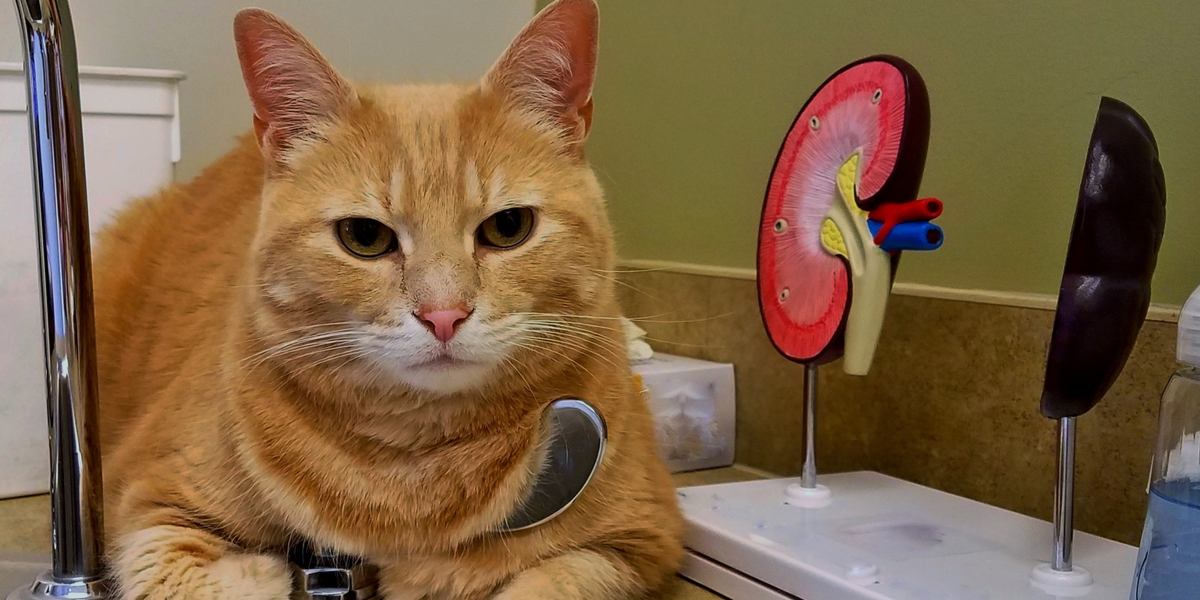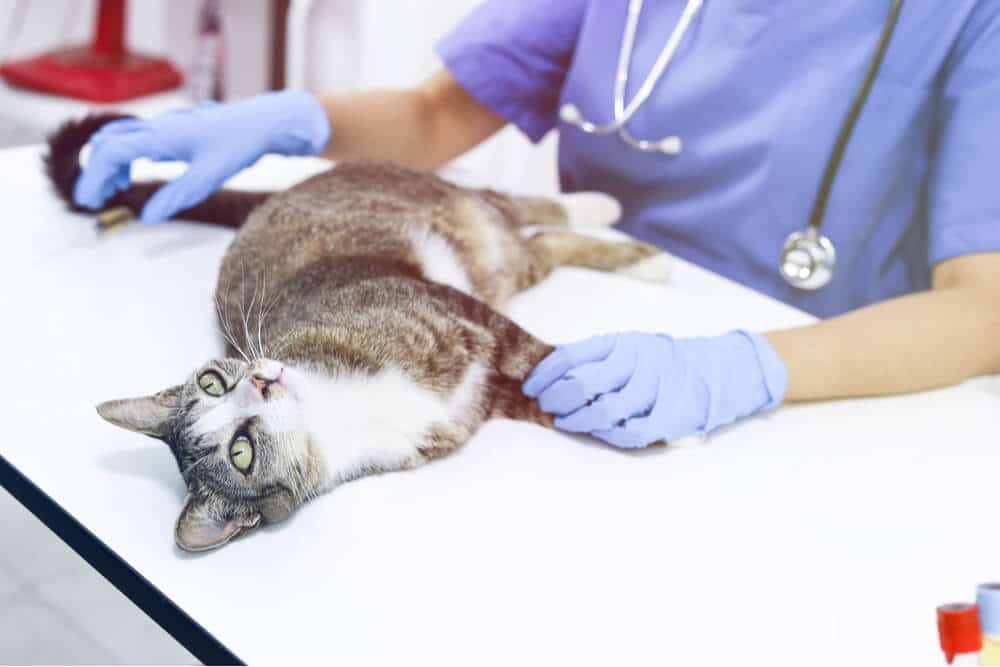
Kidney cancer is one of the less common types of cancer that can affect cats. Nearly all types of cancer are more common in older cats, but renal lymphoma can affect younger cats as well, particularly if they are infected with feline leukemia virus (FeLV). Unfortunately, kidney cancer in cats is very serious, and the prognosis is often poor even with treatment.
In this article we will explore the different types of kidney cancer in cats, the most common symptoms, and how it is diagnosed and managed.
What Is Kidney Cancer in Cats?
Your cat’s kidneys are two bean shaped organs that sit on either side of their spine, just under the rib cage. The kidneys are involved in managing the fluid balance in the body, getting rid of waste products, and maintaining the right balance of salts and minerals. They also play an important role in the production of red blood cells, controlling blood pressure, and keeping your cat’s bones healthy and strong.
Kidney cancer, also called renal cancer, occurs when the healthy cells in your cat’s kidneys grow out of control and become abnormal. This can begin in the kidneys (known as primary renal cancer) or it can begin in another area of the body and spread to the kidneys (known as secondary renal cancer).
What Are the Different Types of Kidney Cancer in Cats?
Unfortunately, most types of tumors found in cat’s kidneys are malignant (cancerous). The most common type of kidney cancer in cats is renal lymphoma, followed by renal cell carcinoma and nephroblastoma.
It is more common that kidney cancer in cats is secondary, meaning it has spread from cancer that began elsewhere in the body. However, primary cancer may also occur.
Because the kidneys have such a good blood supply, cancer in the kidneys tends to spread (metastasize) quickly to other areas of the body, which is why the prognosis for kidney cancer in cats is generally poor.
What Are the Symptoms of Kidney Cancer in Cats?

When diagnosing kidney cancer, your veterinarian may look at a sample of your cat’s urine (urinalysis).
The symptoms of kidney cancer can be quite nonspecific, and include:
- Weight loss
- Lethargy
- Reduced appetite
- Nausea or vomiting
- Abdominal pain
- Enlarged abdomen
- Palpable mass in the abdomen
- Blood in the urine
- Pale gums
You may also see signs of kidney failure, such as drinking more and peeing more, but this is more commonly a sign of chronic kidney disease than kidney cancer.
What Causes Kidney Cancer in Cats?
Old age
Like in people, the risk of most types of cancer increases with age. This is because over time, the cells in our bodies become damaged. The older we are, the more this damage builds up, and the more likely it is that the cells become cancerous. Therefore, kidney cancer is more likely to affect older cats.
Feline Leukemia Virus and Renal Lymphoma
The most common type of kidney cancer in cats is renal lymphoma. Lymphoma is a type of cancer that affects your cat’s white blood cells, and it can affect lots of different parts of the body. This type of cancer is associated with the feline leukemia virus (FeLV), which is more common in middle-aged cats. In fact, around 50% of cats diagnosed with renal lymphoma test positive for FeLV.
The good news is that as more cats are vaccinated against FeLV, this type of cancer is becoming less common. Although currently lymphoma still accounts for 30% of all cancers diagnosed in cats.
How Do You Diagnose Kidney Cancer in Cats?

Some cats with kidney cancer drink more and urinate more, though these can also be signs of kidney disease.
Your veterinarian will take a thorough history and complete a physical examination, including feeling the size and shape of your cat’s kidneys.
Blood tests may be performed at this stage, in particular assessment of your cat’s kidney values, red blood cell count (to check for anemia), and electrolytes such as potassium. These tests will give your veterinarian an indication of how well your cat’s kidneys function, as well as a sense of their general health.
Your veterinarian may also look at a sample of your cat’s urine (urinalysis). It is common with kidney tumors to see protein or blood in the urine.
If abnormalities are found, the next step is often to perform abdominal imaging to take a closer look at your cat’s kidneys using x-rays or ultrasound. An abdominal ultrasound will allow your veterinarian to check the size and appearance of the kidneys, as well as checking other organs, such as local lymph nodes for signs of spread. In some cases, advanced imaging, such as a CT or MRI scan, may be recommended, particularly for full staging of the cancer.
For definitive diagnosis of kidney cancer, your veterinarian will need to obtain a sample of your cat’s kidney. Sometimes a very small sample taken with a needle (called a fine needle aspiration) while your cat is under general anesthetic is enough to make a diagnosis. However, some masses may require a larger biopsy to be taken under ultrasound guidance, or through a surgical procedure.
How Do You Treat Kidney Cancer in Cats?

Your veterinarian can diagnose your cat with kidney failure by performing blood tests
Treatment of kidney cancer in cats depends upon the type of cancer, and whether there is cancer found in other parts of the body as well.
Renal lymphoma is the most common type of kidney cancer in cats. Renal lymphoma is treated with chemotherapy.
In other types of kidney cancer, surgery to remove the affected kidney (called a nephrectomy) may be recommended. This is only possible in cats where only one kidney is affected, and there is no evidence of spread of the cancer to other parts of the body. Chemotherapy or radiation therapy may be advised in combination with surgery to improve the prognosis.
For some cats, chemotherapy or surgery are not the right option, and treatment will be aimed at keeping them as comfortable as possible for the time they have left. Palliative treatment may include drugs such as steroids, anti-nausea medication, appetite stimulants, pain relief and antibiotics for secondary infections.
What Is the Prognosis for Cats With Kidney Cancer?
Unfortunately, kidney cancer in cats generally carries a poor prognosis. This is because kidney cancer tends to spread rapidly to other areas of the body, making treatment difficult.
The average survival time for cats with renal lymphoma is around one to three months for cats receiving corticosteroids and palliative care only, or around six to nine months for those receiving chemotherapy. However, these are average survival times, and some cats have been reported to live a lot longer.
In cats where the cancer is only affecting one kidney, and it has not spread to anywhere else, surgical removal of that kidney can be 100% curative. This type of surgery is very invasive, and does carry a lot of risks, however these cats can make a full recovery.
Is Euthanasia an Option?
For many cats, intensive treatment options, such as chemotherapy or surgery, may not be the right choice. Without these treatments, survival times are often short. However, your veterinary team can support you in keeping your cat as happy and comfortable with palliative at-home care.
Sadly, kidney cancer in cats is very serious, and even with intensive treatment the prognosis is often poor. Your veterinary team is there to help you monitor and assess your cat’s quality of life. Unfortunately, once quality of life is no longer good, euthanasia may be the kindest option.
-
Williams AG, Hohenhaus AE, Lamb KE. Incidence and treatment of feline renal lymphoma: 27 cases. J Feline Med Surg. 2021 Oct;23(10):936-944. doi: 10.1177/1098612X20984363. Epub 2021 Jan 19. PMID: 33464143.







